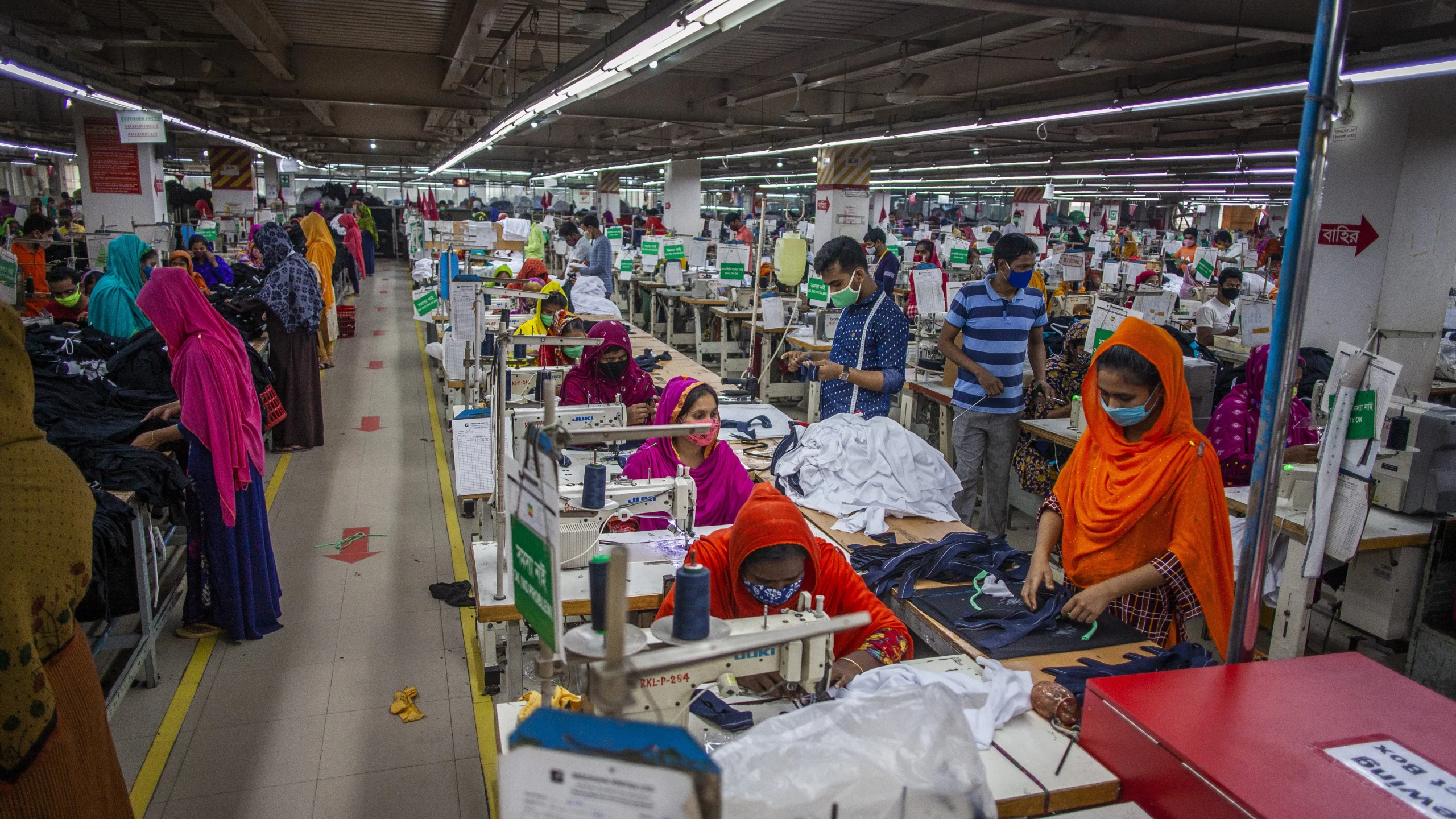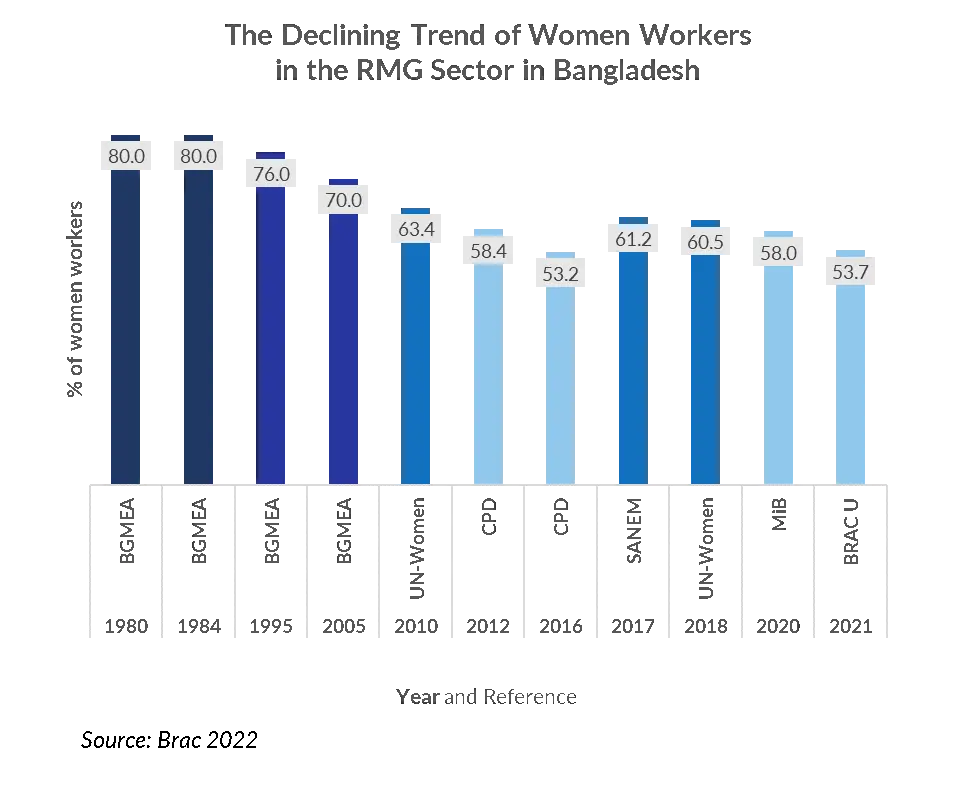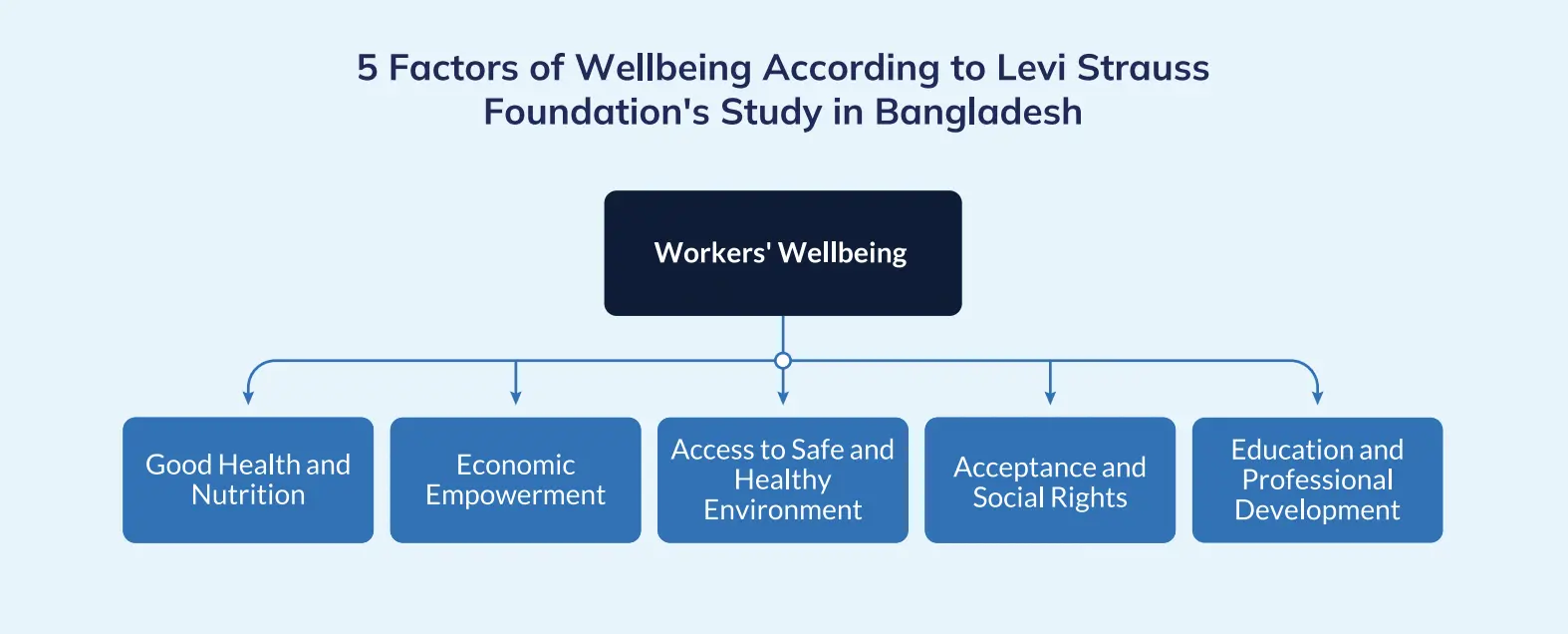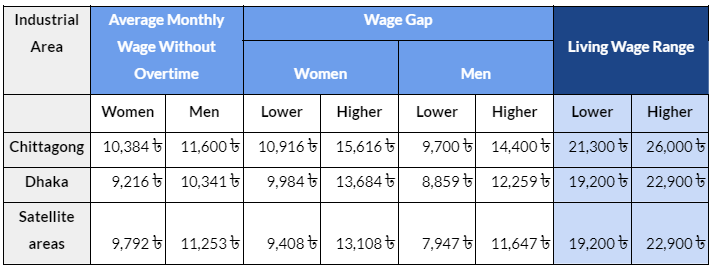GET IN TOUCH
- Please wait...

The Ready-Made Garment (RMG) industry in Bangladesh holds a crucial position in both the nation’s export portfolio and overall economic development.
According to data provided by the Export Promotion Bureau for the fiscal year 2023-2024, the Ready-Made Garment (RMG) industry emerged as a substantial contributor, constituting 84.94% of Bangladesh’s total export earnings in the Knitwear and Woven segments during the July to December period.[1]
According to the Bangladesh Bank in the fiscal year 2023, the Ready-Made Garment (RMG) sector played a substantial role by contributing 10.35 percent to Bangladesh’s Gross Domestic Product (GDP). During this period, the RMG sector garnered total export earnings amounting to USD 46,99 Billion.[2] This remarkable economic growth of the RMG industry has not only been a driver of national prosperity but has also been instrumental in fostering women’s employment.
Women in the RMG sector have emerged as essential contributors to Bangladesh’s success in apparel manufacturing, making significant contributions to the nation’s economic advancement.
As we celebrate these impressive economic achievements, it is crucial to recognize the countless narratives of millions of women working in the RMG sector. Their stories contribute to the greater success of the industry. Before delving into the present scenario, a question arises: What does the current landscape look like for these dedicated and hardworking female RMG workers, predominantly women?

In response to the global fashion industry’s demand for ultra-fast fashion, major apparel giants are relocating production hubs for quicker turnaround times. Bangladesh, a key player in apparel manufacturing, is embracing automation to enhance efficiency and reduce lead times. However, this transition raises concerns about job security, particularly for women in low-wage positions, as socio-cultural barriers hinder the widespread adoption of automation.
According to research conducted by BRAC University in Bangladesh, the percentage of women garment workers has experienced a continuous decrease, declining from 54.22% in 2015 to 53.65[4]. However, the ILO baseline study, based on Survey of Manufacturing Industry (SMI) data in Bangladesh, reveals a nuanced perspective on women’s participation in the workforce. The study indicates that women’s engagement did not plummet from 80% to 61%.
Instead, the data reflects a range of 72% to 76% between 1985 and 1994, followed by a gradual decrease to a range of 65% to 70% from 1994 to 2012. Although the decline is less dramatic, the study underscores a notable increase in the proportion of male workers involved in automation-intensive processes.[5] This prompts a crucial question: Is Bangladesh regressing in terms of women’s participation?
In Bangladesh, deeply ingrained cultural expectations place a significant emphasis on women as homemakers and primary caregivers within the family. These societal norms pose a great deal of challenges for women aspiring to enter the formal workforce, as there is often resistance to deviating from established gender norms. The difficulties are particularly pronounced for women coming from rural areas seeking to transition into formal job markets.
Despite these challenges, the ready-made garment (RMG) industry stands out as a noteworthy exception, showcasing a remarkable representation of women workers. However, the broader societal resistance to altering traditional gender roles remains a formidable barrier, emphasizing the need for comprehensive efforts to overcome these ingrained norms and facilitate greater inclusivity for women in various sectors of the workforce.
The significant increase in women’s employment in Bangladesh’s RMG industry has stemmed from the establishment of a stable income source, positively impacting the lives of many women.
However, despite this progress, there are various factors that make the women in the RMG sector vulnerable both during their active employment and after retirement. Throughout their working years, women workers face challenges related to working conditions, the need for a living wage, access to healthcare, childcare facilities, financial inclusion, and opportunities for upskilling.
Furthermore, the extended working hours without adequate breaks have a lasting impact on the health of women workers. Prolonged periods of standing in the same position, inherent to the nature of their work, contribute significantly to their health challenges.
According to a study result by ILO, a lot of workers leave the industry due to long work hours and its declining effect on their health.[6] Over time, these complications have enduring effects on their overall health, impairing their capacity to secure a better future. Recognizing these factors is crucial for sustaining a healthy and productive workforce, as they directly influence the physical, mental, and financial well-being of employees.
Moreover, after retirement, female workers encounter socio-economic vulnerabilities, a lack of savings and retirement benefits, limited access to health insurance, and difficulties transitioning to less labor-intensive sectors.
According to a survey conducted by the Ethical Trading Initiative (ETI) among former women garment workers, the primary reasons for leaving their jobs included childcare responsibilities, followed by pregnancy, age appropriateness, and challenges in balancing home and work duties. Working conditions, including harassment, violence, long hours, and low salaries, also contribute to job attrition.[7]
Despite the Bangladesh Labour Act’s provisions for maternity leave and childcare facilities, inadequate implementation at the enterprise level emerged as a significant cause for women leaving jobs in the RMG industry.
With the onset of the fourth industrial revolution, the industries in Bangladesh are rapidly progressing in terms of integrating more efficient automated process within the system. This progression is particularly crucial for the Ready-Made Garment (RMG) industry to maintain competitiveness on the international stage. The transition is rapidly underway, with numerous factories swiftly adopting advanced machinery and showing a growing inclination toward automated systems.
According to research by Shimmy Technologies in 2023, 80% of interviewed factories plan to acquire automated machines in the next two years, projecting a 13% increase in their numbers. This shift impacts workforce recruitment, with each machine expected to replace 1 to 6 workers.[8] This transformation necessitates enhanced upskilling initiatives. To navigate this transformation, upskilling initiatives become imperative. As lower-skilled tasks automate, enhanced skills ensure a smoother transition to managerial roles less susceptible to technological changes.
Despite this urgency, a significant skill gap exists between male and female RMG workers, hindering women workers’ advancement to managerial positions. Based on a joint survey of ILO and UN Women, the persistently low representation of women in managerial roles within the RMG sector, stagnating around 9% between 2010 and 2018, exposing pervasive gender-based stereotypes.[9]
Findings from interviews conducted for the landscaping study conducted by LightCastle Partners revealed that, despite the belief that women workers excel in managerial roles, this is not often realized due to social stigmas.
To address this gap, the government, and the industry must prioritize upskilling initiatives, especially for women workers. However, a crucial question arises: are women workers willing to embrace these changes and invest in upskilling?
According to a study by Shimmy Technologies, approximately 70% of women operators express interest in acquiring new machine skills, particularly those linked to advanced machinery.[10] Hence it is proven that the problem was not them being interested in upskilling themselves.
A researcher notes that the lag in women’s technological progress isn’t due to incapability but stems from the opportunity deprivation caused by dual responsibilities. Unlike men who can engage in skill-improving activities outside of work, women face constraints due to immediate family responsibilities post-work, perpetuating the existing skill gap.[11]
Addressing the myriad challenges faced by women workers in the Ready-Made Garment (RMG) sector is not only a moral imperative but also a strategic necessity for the industry’s sustained growth. Factory owners play a pivotal role in ensuring the well-being of women workers, who have been the driving force behind the industry’s success, often at the cost of their own welfare. While the industry has thrived by capitalizing on cost-effective labor, it is now crucial for stakeholders to redirect their focus toward investing in the very workforce propelling its expansion. This shift in perspective is not just an ethical consideration but is essential for the industry’s long-term sustainability.
The current trend of women workers leaving the industry signals a potential threat to its future. To avert such a crisis and secure the industry’s lasting prosperity, prioritizing the well-being of women workers is imperative.

The primary focus of the garment industry should be on establishing a fair wage in the current economic landscape, given the persistent wage gap that plagues the sector. This gap poses a challenge for workers striving to sustain themselves in the prevailing economic conditions, as there exists a considerable disparity between their monthly earnings and a living wage. To truly address the well-being of workers, a concerted effort is required to bridge this gap and ensure that wages align with the cost of living.
Providing suitable accommodation for women workers must be a top priority as many of these workers often find themselves residing in areas lacking proper hygiene and safety standards due to their limited earnings. These subpar living conditions not only impact physical well-being but also significantly affect mental health.
Recognizing this challenge, it is imperative for both the government and the industry to collaborate in ensuring affordable and well-planned housing options near industrial areas. Addressing the living conditions of women garment workers is not only essential for basic welfare but also a crucial step toward cultivating a healthier and more sustainable work environment.
Moreover, the issue of persistent inflationary pressure, which continually diminishes real wages, adds urgency to the need for a comprehensive approach. The existing practice of a new wage board every four years is deemed inadequate for timely adjustments, emphasizing the necessity for more frequent and responsive mechanisms to counter the impact of inflation on workers’ livelihoods.

According to findings from the Garment Worker Diaries, there is a significant disparity between the wages earned by garment workers and the minimum wage necessary for a comfortable living in the present economy. In Q2 2022, the median earnings for a regular work month (excluding overtime) were reported at Tk. 9,984. However, a notable wage gap exists between genders. The extent of the gap varies based on the area and the living wage benchmark applied, ranging from Tk. 9,408 (49%) to Tk. 15,616 (60%) per month for women and Tk. 7,947 (41%) to Tk. 14,400 (55%) for men.[14]
Amidst global conflicts and inflation, the prices of basic commodities have surged, posing challenges for those with lower incomes, especially in cities like Dhaka. Consequently, there has been an ongoing demand to raise the minimum wage for garment workers, leading to a recent revision.
Effective from December 1, 2023, the minimum wage for Ready Made Garment Workers in Bangladesh has been increased to BDT12,500.00 per month, marking a substantial 56% rise from the previous BDT8,000.00. Despite this increment, it remains insufficient. A study by the Center for Policy Dialogue in 2023 revealed a 25% increase in non-food expenses for workers’ families, reaching an average expenditure of BDT12,882, compared to BDT10,313 in 2022.
According to their findings, the minimum wage in the garment sector should be BDT17,568 to align with the current economic conditions.[15]
In the contemporary context, worker wellbeing in the industry goes beyond wages, where one of the key areas to focus on is their health. The study revealed that women workers in the RMG sector encounter difficulties in discussing their health problems with supervisors, primarily due to gender disparity within the managerial hierarchy. The discomfort stems from the fact that most supervisors are men. In this regard, one woman said, “When we have our periods, some of us get sick from an excessive discharge of blood, we need to go the toilet to change frequently, but we cannot share our problems because we are embarrassed, and they are all men around us.” [16] This emphasizes the need for a more inclusive and supportive approach within the industry.
Additionally, the taboo surrounding menstrual health, coupled with a lack of awareness, contributes to the challenges faced by women garment workers. Many still use clothes instead of sanitary napkins due to affordability issues, which pose health risks and affect productivity.
A survey carried out in September 2020 by the South Asian Network on Economic Modeling (SANEM) and Microfinance Opportunities (MFO) regarding family planning and menstrual health among garment factory workers in Bangladesh revealed that merely 34 percent of women workers opt for sanitary napkins during their menstrual cycles, with 44 percent continuing to use cloth instead.
Furthermore, RMG workers in Bangladesh often rely on over-the-counter medications due to financial constraints, highlighting the urgent need for proper health insurance coverage. To address this concern, industry owners can consider implementing a collaborative model with the government, where the premium cost for health insurance is shared among workers, the industry, and the government.
Drawing inspiration from successful initiatives such as the pilot project supported by SNV Netherlands Development Organization and led by Gonoshasthaya Kendra (GK), which aimed to enroll a minimum of 20,000 garment workers in a cost-effective health insurance program. This innovative approach, spanning from June 2017 to May 2021, demonstrated a practical way to mitigate healthcare challenges by providing RMG workers with access to affordable health insurance benefits.[17]
A significant number of women workers in the RMG sector experience a lack of control over their financial decisions, often attributed to insufficient financial literacy and inadequate savings management. Compounded by societal norms and prevailing power dynamics within households, where male members often dictate financial decisions, women workers encounter heightened difficulties in this regard. This lack of control in financial autonomy can lead to challenges in their daily lives.
Notably, a survey revealed that the spouses of 46% of married women RMG workers did not support the idea of their wives having personal bank accounts. This figure increases to 49% when it comes to personal bKash accounts registered under the individual’s name.[18] The prevalent barriers as well as lack of awareness and gaps in financial literacy among women RMG workers in Bangladesh underscore the need for concerted efforts from industries to address this issue. Enhancing financial education and promoting better savings practices are essential steps toward ensuring the financial inclusion and empowerment of these workers.
With the onset of the 4th industrial revolution, traditional dynamics in the RMG sector are undergoing significant changes. Relying solely on cost-competitive labor is no longer a sustainable competitive advantage. It is vital that we proactively prepare our workforce for these transformations. The implications of these changes are felt disproportionately by women garment workers, particularly those in lower-tier positions susceptible to automation.
Women in the RMG sector, often employed as sewing machine operators, face heightened vulnerability to job displacement by automated systems, with many unaware of the potential shift toward robotic automation in the future.
According to a 2019 report from the Government of Bangladesh, more than 500,000 jobs in the RMG and textile sectors are anticipated to be in jeopardy by 2041, with a specific emphasis on positions held by female workers.[19]
To safeguard the well-being of women in the RMG workforce, it is crucial to focus on skills development and raise awareness. The misconception among factory owners regarding women’s ability to manage machinery needs correction for a more inclusive and resilient industry.
Women in the RMG sector have played pivotal roles as key drivers since the industry’s inception. Ensuring their wellbeing is not only a moral imperative but crucial for securing their future within the sector. Beyond addressing immediate needs like healthcare and necessities, there’s a pressing need to focus on upskilling initiatives.
As the global landscape shifts toward increased automation, Bangladesh is also following suit. Women RMG workers find themselves in a vulnerable position as their tasks are prone to automation, and there is a noticeable lack of initiatives for their upskilling.
However, upskilling in the RMG sector faces several challenges, notably the phenomenon of frequent job switching. Approximately 15% of the industry’s task force changes jobs every month, creating a dynamic and unstable employment landscape.[20]
This high turnover rate not only hinders the effectiveness of upskilling initiatives but also raises concerns about the sustainability of investments in employee development. Moreover, there is a significant challenge in the lack of openings in higher positions for skilled workers.
Even with enhanced skills, many employees find limited opportunities for career advancement within the sector. Without clear pathways for career progression and incentives for skill acquisition, employees may struggle to see the tangible benefits of engaging in upskilling initiatives.
Many women garment workers retire at the age of 35, necessitating significant investment and thought into post-retirement opportunities. Exploring adjacent industries and implementing skill transfer initiatives is crucial.
Despite automation trends, there’s potential for growth within the sector, creating new jobs that demand a more skilled workforce. Foreseeing these changes and taking proactive initiatives is essential for the continued success of women in the RMG sector. Empowering these women through upskilling is crucial, not only to prepare them for a sustainable livelihood after retirement but also to enhance their contributions while actively in the workforce.
Additionally, industry owners should prioritize worker well-being, especially considering the increased focus on workers’ safety and welfare by the countries Bangladesh exports to. Non-compliance with these standards may lead to severe consequences.
The European Union (EU) holds a significant position as one of the major markets for Bangladesh’s RMG sector, with clothing constituting over 90% of the EU’s total imports from the country, according to the European Commission.[21] This underscores the EU’s crucial role, representing more than half of Bangladesh’s overall RMG export market.[22]
Hence, it becomes imperative for industry owners to adhere to the Human Rights and Environmental Due Diligence (HREDD) standards established by the EU. Non-compliance with HREDD regulations carries severe consequences, including potential loss of access to the EU market. Furthermore, Western brands sourcing RMG products from Bangladesh are increasingly implementing stringent monitoring systems for human rights and environmental impacts across the supply network, emphasizing the need for strict adherence to HREDD standards.
In light of these considerations, as the EU market has been highlighted, it is paramount for the industry to take proactive measures regarding the well-being of women workers within the sector. Neglecting the upgrading and upskilling of these women may have long-term consequences, as the industry’s success is intricately tied to the empowerment and continuous development of its female workforce.
Sakina Binte Belayet, a Trainee Consultant at LightCastle Partners, has prepared the write-up. For further clarification, contact here: [email protected]
Our experts can help you solve your unique challenges
Stay up-to-date with our Thought Leadership and Insights